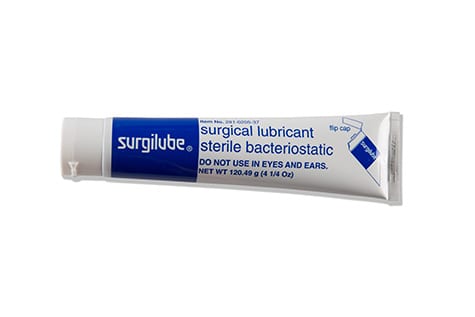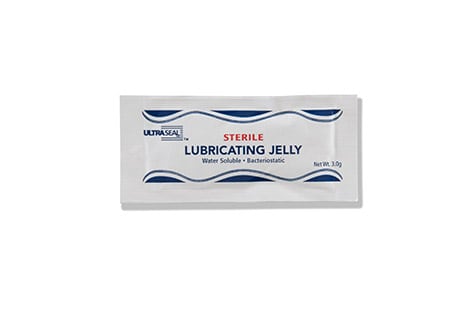If you are new or a novice to self-catheterization, you know how essential comfort is to the process. Inserting a tube into the urethra that is smooth and slick yet not messy will provide the best catheterization experience and put you at ease. Using a high-quality catheter lubricant to lubricate your catheter is an essential step in self-catheterization. We will dive into why this catheter accessory is important and how to use it to lubricate your catheter.
Why a Urinary Catheter is Needed
A catheter is needed when you are unable to urinate on your own. When urine builds up in the bladder, it can be uncomfortable and also cause problems such as serious kidney infections if left untreated. Self-catheterization is a way to completely empty your bladder when you need to. A thin, flexible tube is inserted into the urethra until it reaches the bladder. The catheter then lets the urine flow out into an attached urinary drainage bag.
Urinary catheters are used for a variety of reasons, such as:
- Lengthy surgical procedures when you are under anesthesia and unable to control your bladder.
- Nerve damage caused by a medical condition such as Multiple Sclerosis or a spinal cord injury.
- Urinary incontinence that causes leakage or urinary retention that causes you to be unable to urinate.
- An enlarged prostate, which can narrow the urethra or put additional pressure on the bladder.
Regularly emptying your bladder may prevent urine leaks and help prevent kidney damage from blocked urine and infections.
It is essential to stay clean when using a urinary catheter to help prevent infection. Part of this process is using a high-quality lubricant for catheters or choosing a hydrophilic or pre-lubricated catheter.
Using a Lubricant to Lubricate Your Catheter
If you’re using an uncoated straight catheter, it is recommended to use a high-quality catheter lubricant for a comfortable experience. When you lubricate your catheter, you may reduce the risk of urethral trauma and potential infections.

Choosing Your Lubricant to Lubricate Your Catheter
Catheter lubricant should always be used when inserting an intermittent urinary catheter to reduce pain, discomfort, and friction. The use of lubricant to lubricate your catheter may also help reduce infections such as urinary tract infections (UTI). Choosing a high-quality sterile lubricant for catheters will aid in the most comfortable catheterization experience and do the best for you.
Some essential features of a high-quality lubricant to keep in mind when choosing your self-catheter lubricant include:
- Water-soluble lubricant – offers the most comfortable slickness and will not compromise the integrity of a silicone catheter.
- Viscous lubricant – reduces friction and makes the process smoother.
- Bacteriostatic lubricant – contains agents that inhibit bacterial growth, which helps prevent infection.
Personally Delivered carries a wide variety of catheter lubricants from trusted brands such as Cardinal Health, McKesson, Cure Medical, Surgilube, HR Pharmaceuticals, and more. All of our catheter lubricants to lubricate your catheter that we carry are safe, sterile, and water-soluble. Lubricants for catheters are available in different packaging styles, all of which are convenient sizes for travel or on the go.
Healthcare professionals have used lubricants for catheters in flip-top caps or screw-on caps, such as Surgilube lubricants, since 1932. This catheter lubricant is water-soluble, sterile, viscous, and bacteria-inhibiting. Surgilube minimizes friction to provide a smooth and comfortable catheterization experience from start to finish.
HR Pharma Lubricating Jelly comes in a convenient 3-gram or 5-gram foil packet or in a 4-ounce tube. This catheter lubricant to lubricate your catheter is sterile, greaseless, water-soluble, and easy to clean up. The OneShot foil packets are designed to be easy to open and contain just the right amount of catheter lubricant for each use. HR Pharma Lubricating Jelly in the flip-top cap option is easy to open and close using just one hand for those with dexterity problems.
How to Lubricate Your Catheter
Now that we have discussed the need for a catheter and the importance of choosing a high-quality lubricant, we will provide general instructions on how to lubricate your catheter and insert it. Your doctor should provide you with basic instructions when prescribed your catheters; however, you may find these instructions a bit more detailed.
Prepare the necessary supplies
 You will need the following items:
You will need the following items:
- Anti-bacterial soap and warm water or personal antiseptic wipes
- Your clean intermittent catheter
- Catheter lubricant (not petroleum jelly or Vaseline as they are not water-soluble)
- A waterproof bed pad
- A container to hold the urine or the toilet
Prepare for insertion
- Try to urinate first before using your clean catheter.
- Wash and dry your hands with anti-bacterial soap and warm water.
- Clean the end of your penis or genital area well with anti-bacterial soap and warm water or personal cleansing wipes. If you are a male and not circumcised, make sure to clean under the foreskin, too.
- Sit or lie down with knees bent and place the bed pad under your penis or genital area. Put the collection container close to you, or if you are using a toilet, make sure to stand directly above it to catch any urine.
Lubricate your catheter
- Spread the catheter lubricant on the tip of the urinary catheter, lubricating only the first half of the intermittent catheter. You will need a good amount of catheter lubricant to ensure the catheter will not cause friction to your urethra.
- Place the other end of the catheter over the toilet bowl or in the container to catch the urine.
*Using sterile, water-soluble, viscous, and bacteriostatic catheter lubricant to lubricate your catheter will reduce pain, risk of infection, and urethral damage. Remember to make sure you choose a high-quality lubricant for catheters for a clean and comfortable catheterization experience.
Insert the intermittent catheter
- Gently insert the catheter into the urethra opening. Slowly move the catheter in until urine begins to flow. Push the catheter in about another inch and hold it in place.
- Allow the urine to drain into the collection container or toilet.
- Remove the catheter slowly when urine stops flowing.
- Wash and dry your hands.
Catheters are not meant to be reused and are to be discarded after each use. The self-catheterization process should never hurt or cause sharp pain. If the catheter is not going in, stop and take a moment to relax. A catheter should never be forced into the urethra. This action could cause severe trauma and tear this sensitive tissue.
Watch these short videos for a demonstration.
When to Contact Your Doctor
Don’t ignore signs of an infection, any pain, or other concerns. You should contact your doctor if you experience any of the following symptoms:
- Burning or pain when you urinate. You might have a urinary tract infection (UTI).
- You cannot urinate or not passing much urine at all.
- There is blood in the urine, or there is a foul smell.
- Nausea or vomiting.
- Too much pain upon insertion of your catheter despite the use of lubricant to lubricate your catheter.
- You have a fever of 100.4°F(38.0°C) or higher, as advised by the CDC (Centers for Disease Control and Prevention)
At Personally Delivered, we are proud to be a supplier of a variety of high-quality catheter lubricants to lubricate your catheter for comfort. Choosing the right catheter lubricant is one of the most critical steps in a safe, clean, and comfortable self-catheterization experience. Our catheter Product Experts are here to assist if you need help choosing the catheter gel or jelly to lubricate your catheter. We will make it easy for you.
Popular Catheter Lubricants
Disclaimer: Important Notice Regarding Medical Advice
The information provided in this blog is intended for general informational purposes only and should not be considered a substitute for professional medical advice, diagnosis, or treatment.






